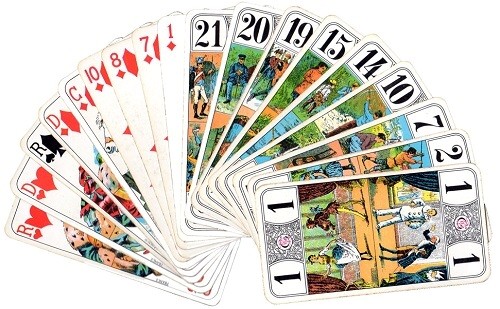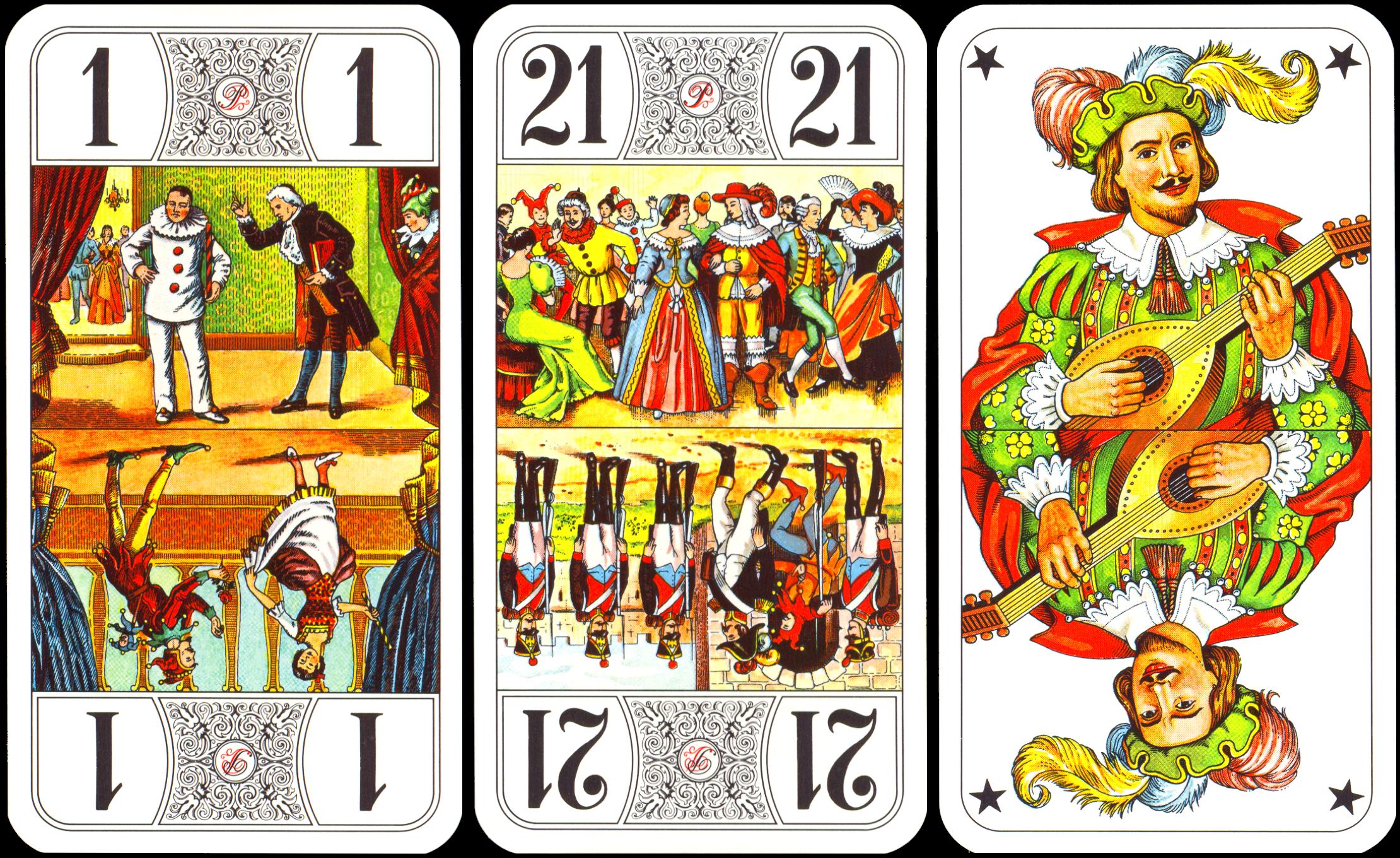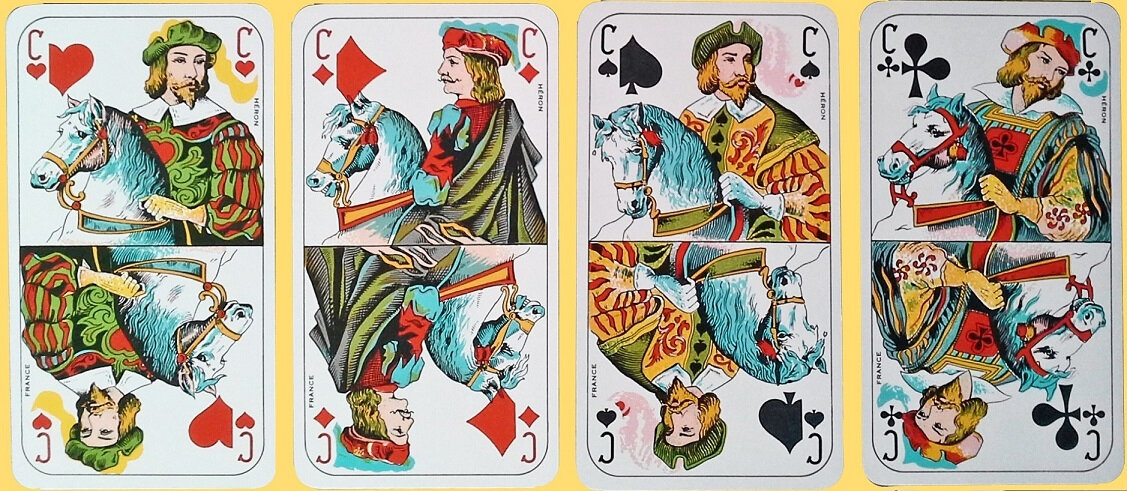
Tarot
Cards Game
Jeux
Jeux de Cartes / Card Games

Historical
Tarot is the ancestor of all card games.
Introduced in Europe by the Saracens during the invasion of Italy in the 10th
century, tarot cards were the first European cards (the first known game dates
from 1379).
But if, until the Renaissance, they were used only to predict
the future, the tarots did not long remain the prerogative of fortune-tellers,
mages and fortune-tellers. They soon became a game whose success has persisted
for more than five centuries now.
The word "tarot" comes from the Italian
"torocco"; but there the mystery begins.
Some have argued that the word
derives from "rota", the wheel, this symbol of fate. For others, it would come
from "tora", the Jewish law.
We also thought of an Egyptian term
designating the path of life and a Greek word that could refer to the
ornamentation of the back of these cards made of compartments in grisaille.
In fact, we also designate under the name of tarot the back of the cards
when it is not united.
The tarot is not Egyptian, as legend has it, but
it was born in Lombardy around 1430.
This is why he first adopted the
colors of the Italian games: cups, swords, staves and denarii.
This game
was then called trionfi, Frenchified in “triumphs” (in the feminine!).
In
the following century, it was replaced by tarocchi, a term which almost
immediately became tarot in French.
In the 16th century, the tarot
entered Germany, and it was there, paradoxically, that it took on more legible
French colors (spades, diamonds, hearts, clubs).
This graphic mutation in
no way affects the rules of the game, but opens the doors to Northern Europe as
far as Denmark, and also those of the Austro-Hungarian Empire.
However,
in its Italian homeland, the game hardly survives except in the "reduced" area
of Piedmont, in Bologna and in a few Sicilian villages. France is today the
country where we play tarot the most!
Number of players 4
Material: 1 tarot deck of 78 cards.
Goal of the game
The taker tries to make a contract, the defenders try to prevent him from
doing so.
Card details:
The game has 78 cards called
"blades".
If the tarot stands out against the landscape of card games, it
is certainly not by its rules, which are the basis of all modern games, but
above all by its cards.
First there is their imposing size, then their
number: 78!
A beginner (especially a child) often has some trouble
holding 18 cards of this size!
These 78 cards are distributed as follows:
4 families of 14 cards (spades, hearts, clubs, diamonds), i.e. by decreasing
rank, king, queen, knight, valet, 10, 9, 8, 7, 6, 5, 4, 3, 2, ace.
The
king is the strongest suit card, the ace the weakest.
These cards consist
of 21 numbered trump cards (from 1 to 21) and a special card: the EXCUSE (or
fool).
In some traditional tarot cards the four suits are: sword, cup,
wand and denarius. But in general we use are that of the French games (clubs,
hearts, spades and diamonds).
In addition to the number, each asset
represents a subject:
|
1 |
le
Bateleur
|
2 |
la Papesse |
3 |
l'Impératrice |
4 |
l'Empereur |
|
5 |
le Pape |
6 |
l'Amoureux |
7 |
le
Charriot |
8 |
la Justice |
|
9 |
l'Ermite |
10 |
la Roue
de Fortune |
11 |
la
Force |
12 |
la Mort |
|
13 |
le
Pendu |
14 |
la
Tempérance |
15 |
le
Diable |
16 |
la Foudre ou la Maison-Dieu |
|
17 |
l'Étoile |
18 |
la Lune |
19 |
le
Soleil |
20 |
le Jugement |
|
21 |
le
Monde |
|
|||||
Special tarot cards
|
the other 19 assets
|
the 3 « Oudlers » |
the 4 Knight  |
Details of 2 tarot trump cards In the 19th century, the so-called “profane” scenes succeeded the traditional figures of the “Marseille tarot cards”, used for divinatory purposes.
The Oudlers...
In the family of trumps, we distinguish the 1 and the 21 which, with the Excuse,
are named “Oudlers” or “oudlers”.
The 21 and the Excuse are said to be
"impregnable", whoever counts them in his cards at the start of the game will be
certain to find them in the folds of his camp at the time of the count.
The 1 of trumps, baptized the “Petit”, is, him, “taken” by the opposite camp.
Note, among the figures, the presence of an additional card, the knight,
hierarchically placed between the queen and the valet.
• 21 numbered
cards, in ascending rank, from 1 to 21: the trumps.
The highest and the
lowest, which are part of the 3 "ends", have special functions and play an
important role in the final point count.
• The Excuse: The seventy-eighth
card, adorned with a star and a mandolin player (some see it as reminiscent of
the game's Italian origins), is a sort of all-purpose card. It is also the third
“end”.
Card value and distribution
The tarot is a game of tricks with
trumps (it is even, historically, the first), where a single attacker opposes
the camp of the defenders, all having the objective of totaling a minimum number
of points.
These points won or lost as the case may be will be multiplied
by the coefficient specific to each auction.
It is also one of the very
rare games where the value of the cards is expressed in half points (see below).
The 78 cards alone represent (without bonuses) a total of 93 points.
| Value of cards in points | Minimum points for a contract |
| Kings and
Oudlers 4½ Queen 3½ Knight 2½ Jacks 1½ other cards ½ |
36 points for the taker who
has the 3 Oudlers 41 points with 2 Oudlers 51 points with 1 bout 56 points without any bout |
The goal of the game.
The Tarot is at the same time an individual and a team game.
Indeed, during a deal, one of the players (the Taker) is matched against the three other players (the Defenders) who form a team.
But this situation lasts only during each single deal. The Taker contracts during the bids that he will reach with his tricks a minimum amount of points.
This minimum amount is determined only by the number of Oudler(s) that the Taker will have among his tricks at the end of the game:

The minimum amount of points to reach does not depend on the bid taken.
The choice of the Dealer.
Before the first deal, all the cards are laid down backside and each player chooses one up. The lowest card designates the first Dealer.
A Trump is higher than any suit card.
If there is equality, the following priority order between the suits is applied: Spades - Hearts - Diamonds - Clubs.
Therefore the Ace of Clubs always designates the first Dealer.
The player who takes the Excuse must choose another card. For the next deals, the player placed on the right side of the previous Dealer becomes the new one.
The split and the deal.
The player facing the Dealer shuffles the cards. The pack face down is split in two parts by the player placed on the left side of the Dealer. The smallest part of the pack must contain at least 4 cards.
The cards are dealt counter-clockwise three by three. The Talon, or "Dog" ("le Chien" in French), is composed of 6 cards.
It is made during the dealing at the will of the Dealer one by one but without the first and the last card of the pack.
If the Ace of Trumps is the only Trump (including the Excuse) into one of the hands, this player must show his cards and that deal is not played.
The bids.
After having seen their hands,
each player bids, beginning by the player placed on the right side of the
Dealer.
Each player can only bid one time.
He can pass or he must bid at a higher level than the
players before. The possible bids are as following:
• Pass.
If all the
players are passing, the deal is not played and the player placed on the right
side of the dealer makes another deal.
• Take.
• Guard.
For
these two bids, only the computation of the scores differs. After the bids, the
Dog is turned up and showed to the all the players.
Then its cards are included into the Taker's hand. In
return, he must discard six cards, without showing them, but these cards will be
included into the amount of his tricks at the end of the deal.
• Guard
Without.
The Dog is not showed up but is included downside into the tricks
of the Taker.
• Guard Against.
The Dog is not showed up but is
included downside into the tricks of the Defenders.
The Discard.
The player who bade a Take or a Guard includes to his hand the 6 cards
of the Dog.
Then he discards 6 of his 24 cards. This Discard stays secret but will be included into the tricks of the Taker.
The Taker cannot discard neither Oudlers nor Kings.
He can discard a Trump only if he has nothing else than
Oudlers, Kings and Trumps. In this case, he must show to all the Defenders the
discarded Trumps.
Playing the cards.
The opening is made by
the player placed on the right side of the Dealer.
The order of the play is counter-clockwise.
Each
trick is won by the highest Trump played, or the highest card of the suit if no
Trumps were played.
The player who wins the trick opens the next one.
If a card of a suit opens a trick, each player has to follow the same suit. If a
player has no cards of the requested suit, he must play a Trump.
When a player has neither cards of the requested suit,
nor any Trumps, he plays any other card he wants.
If a Trump opens a
trick, each player has to play a Trump, except when he has none, in which case
he is free to play
any card he wants.
Whenever a Trump has to be played, either after a Trump opening or instead of a missing suit, a Trump higher than the highest played so far in the same trick is requested.
If the player cannot play a higher Trump, he has to play
any other Trump. But he has to play a Trump, except if he has none, in which
case he is free to play any other card he wants.
If the opening of a
trick is the Excuse, then the second player of this trick determines the played
suit (or Trumps).
The bonus.
•The Ace of Trumps at the end (in French: "le Petit au
bout").
If the Ace of Trumps is in the 18th and last trick, the side who
wins this trick gains a bonus of 10, multiplied according to the contract (see
the Score section), whatever the winning side of the deal.
• The Handful
(in French: "la Poignée").
A player which has 10 or more trumps into his
hand can at his own choice declare a Handfull, either Simple, Double, or Triple.
Before he plays his first card in the first trick, he has to show the right
number of trumps as following:
Simple Handful, or 10 Trumps, for a bonus
of 20.
Double Handful, or 13 Trumps for a bonus of 30.
Triple Handful, or
15 Trumps for a bonus of 40.
This bonus cannot be multiplied (see the
Score section) but is added to the score of the winning side of the deal.
The Excuse shown inside a Handful indicates that the player has no other
Trumps in his hand.
The Slam.
The Slam consists to win all
the 18 tricks of a deal...
The Slam can be declared by the Taker in
addition to the contract he bade. An extra bonus (not multiplied, see the
Score section) is added to the score of the deal:
• Slam declared and
made: a bonus of 400 points.
• Slam not declared but made: a bonus of 200
points.
• Slam declared but not made: a forfeit of minus 200 points.
The Slam can be declared after the Discard. In any case, the player who declares
a Slam makes the opening.
If the player who is trying to complete a Slam has the Excuse, he can play it at the last trick and he wins this trick if he has already gained all the other tricks.
In this case, the Ace of Trumps is considered to have
been played "at the end" if it was played at the trick before the last one.
The Score.
To win the bid he has contracted, the Taker must reach a
minimum amount of points according to the number of
Oudler(s) he has in his
tricks at the end of the played deal (see the goal of the game section).
If the amount of the points in the tricks of the Taker is
less than the required one, the Taker loses his bid.
A bid is worth 25
points to which are added to (or subtracted from) the points of the tricks that
are above (or
under) the required amount of the points.
This number is multiplied by 2 with a Guard, by 4 with a Guard Without or by 6 with a Guard Against.
The same figure is subtracted from (or added to in the case of a lost bid) the score of the three Defenders, and added 3 times to (or subtracted 3 times from in the case of a lost bid) the score of the Taker.
Therefore, before each new deal, the sum of all the
scores is always 0.
An example of scoring:
the Taker wins a Guard with 43 points, 2 Oudlers and the
Ace of Trumps at the end.
Because he has two Oudlers, he had to
make 41 points to win his bid.
Therefore, his gain is 43 - 41 = 2 pts.
The computation for an successful Guard is then
(25 +
2 + 10 (for the Ace of Trumps at the end)) x 2 (for the Guard) = + 74 pts.
The result gives - 74 pts for each of the three Defenders and + 74 x 3 = + 222 pts for the Taker.
